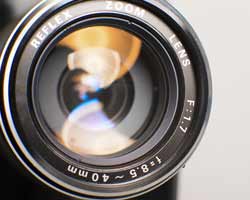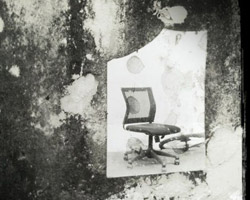Perhaps you've seen articles about this topic in photo magazines or maybe you've noticed arguments on some of the photography discussion groups online. So what is the fuss all about? Simply stated, Live View is the ability to frame your shot with the LCD monitor on the back of certain DSLR cameras instead of through the optical viewfinder. Until fairly recently, that was impossible. Now almost every manufacturer has at least one model with this feature.

The basic concept is not really new. Virtually all point-and-shoot digital cameras (sometimes referred to as digicams) give you this capability and have for a long time. In fact, some of the newest models lack any kind of optical finder. With those you really have no choice but to frame your shot with the LCD screen (or the electronic viewfinder on EVF models, which is really an eye-level version of the same thing). So why on DSLRs all of a sudden? Well, I guess a cynical answer might be because the manufacturers' engineers have figured out how to do it, so they do. More features would tend to translate into higher retail prices and more profit for the companies. However, this theory fails to take into account the fact that DSLR prices have steadily fallen over the years. A better explanation, I think, is that amateurs have gotten used to Live View on their digicams so what better way to get them to upgrade to a DSLR than to offer a feature they're familiar with. Amateurs make up the vast bulk of the camera-buying public and they drive the market. Working pros are actually a tiny segment of that market though as individuals they may spend more money on their gear. And don't forget the extra expenditures, at least potentially, involved with a DSLR camera for lenses, flashes, and other accessories.
Ok, that probably sounds a little cynical too so let's cut to the chase. If you have a nice bright through-the-lens optical finder, why would you want to frame your shot with the LCD screen? Well, hopefully you won't photograph by holding the camera at arms length like many snapshooters do. Your arms will get pretty tired, especially if your DSLR is fairly heavy, not to mention the inherent camera shake such a technique will produce. No, what you can do with Live View is preview your shot before you actually take it, checking for correct exposure, color, sharpness (focus correction must be made via the optical finder on some models), etc., make any changes necessary, then snap the shutter. This might be faster than taking the photo, then checking it on playback. But most DSLRs have pretty fast write times, even shooting RAW, though the only way to see if any changes you make are correct is to take another photo. Live View lets you see the chnages in real time. That's what "Live" View means.

Another plus — more precise framing. Most LCD monitors display 100% of what the camera's sensor captures. Only the very high-end DSLRs have optical viewfinders that feature this. Precise framing is virtually a necessity with macro photography but you might find you also want it for things like architectural subjects, scenics or whatever. And here's another plus: If your subject (or preferred shooting position for that subject) is down on the ground, you can flip the LCD screen up and view it more comfortably than you could with the optical finder. At least you can with those camera models that have such an articulating screen. Unfortunately, only two of the DSLRs I look at offered this — the Olympus E-3 and the Sony A300/350 — but not everyone needs this capability.
What else? Well, if you do studio-type portraiture, you'll love Live View even if the camera lacks an articulating screen. An important aspect of portraiture is eye contact with your subject so you can keep their attention and better communicate with them. That's difficult to do if you have your head pressed against the rear of the camera while peering through the viewfinder. Very young children (and babies) can sometimes find that rather scary. Look at it from their point of view — they see this person with a machine for a head.

Exactly how Live View is achieved does vary a bit from one camera to another. More important is which camera features can be accessed while in this mode. The Olympus E-3 lets you do pretty much everything, even view a live histogram, just like the better digicams. Same for the Sony I mentioned. Some of the other models are little more than viewing systems. Autofocus is often limited and cannot be done directly in Live View mode without first dropping the mirror, then enabling the TTL autofocus system. Sony has solved this problem by employing a secondary sensor, rather than the main capture sensor, thus avoiding any blackout. Nikon's approach on the D300 is to include two Live View modes, one for tripod and one for hand-held work. The latter uses the mirror-drop option but the former employs contrast-detect AF common on digicams and avoids interrupting the Live View display. The Canon Rebel XSi is similar but the Canon 40D has the mirror drop-down approach, as does the Pentax K20D.
How important is the capability to autofocus in Live View mode? In my opinion, not very, and that brings us to hw you are going to actually use Live View. Fast action? I don't think so. The optical finder is still going to be better for that. Taking pictures in bright sunlight? Probably not. It's true that LCD screens have improved their visibility under those conditions but the viewfinder is still better.
OK, so we have portraiture, macro, maybe scenics, and any situations where very precise framing is needed. Those are the main applications suitable for Live View and none of them really require autofocus. As for manual focus, it's often easy in Live View due to the ability to magnify the image. Anyway, manual focusing is better for portraiture and macro work. Autofocus systems are not perfect and will sometimes zero in on parts of the subject you don't intend it to. In portraiture, for example, you might get tack-sharp ears but slightly out of focus eyes.
So the question now arises — if you are in the market for a new DSLR, should you concentrate on those models that feature Live View? Well, that depends on your photographic needs. But considering the current market trend, it may be difficult in the near future to find a camera that does NOT have Live View.
Who wants Live View? Well, certainly folks moving up from a digicam. Advanced amateurs and other photo enthusiasts, probably. Working pros, perhaps not but that will depend on their photo specialty. As for myself, I don't need it, at least in my DSLR. I do shoot portraits sometimes but for that I use my Olympus C8080, a great digicam with a flip-up LCD screen. Also, for portraits I much prefer the 4/3 format on this camera to the more common 3/2 proportions on most DSLRs but that's a topic for another time.
If your DSLR camera lacks Live View, then you don't miss Richard's article on an alternative solution called ZigView - A Viable Alternative






